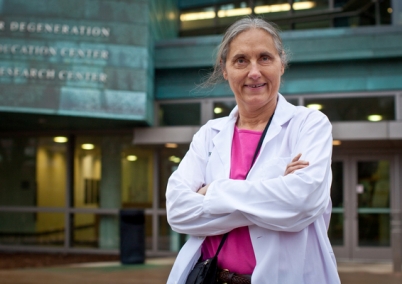
Note: See the end of this story to view video of Dr. Wahls’ TEDx Iowa City presentation.
By Gigi Wood
She can walk.
Dr. Terry Wahls, a clinical medicine professor at the University of Iowa Carver College of Medicine, has achieved what few in this world have. Diagnosed with secondary progressive multiple sclerosis (MS), Ms. Wahls, who at one point was confined to a wheelchair, is not only up and walking, she is working on clinical trials to repeat her personal results.
Her cure: intense nutrition, meditation, self massage, physical therapy and neuromuscular electrical stimulation. The cornerstone of her recovery has been intensive nutrition regimen, which is now known as the Wahls Diet.
“I expected to be confined to bed, not working, facing dementia, so I’m very grateful to have my life back,” Ms. Wahls said. “It puts me in a very unique place spiritually, mentally and scientifically.”
Ms. Wahls has completed several books, videos, essays and other publications about how she has overcome her disease. Fifty percent of sales are applied toward MS research. She also presents lectures and classes on the topic locally. Most recently, she was invited to speak at TEDx Iowa City on Nov. 11 at hotelVetro.
Meanwhile, she spends her work days studying the disease and treatments and is constantly pursuing funding for her research, which is not always an easy task, despite her treatment success.
Background
Ms. Wahls had spent 13 years in private practice inWisconsinbefore moving her family toIowa Cityin 2000 to work at UIHC. That year, she was diagnosed with relapsing remitting MS. Within three years, she had transitioned to secondary progressive MS.
She underwent chemotherapy to slow her disease. Her back muscles became so weak, she needed to use a tilt-recline wheelchair. She worked to accept her fate that one day she would be confined to a traditional wheelchair. But she was determined to slow that progression for as long as possible.
Ms. Wahls began studying the latest research in MS and found most of the innovative drug therapies were years away from Food and Drug Administration (FDA) approval. So she took another route and began looking at vitamins and supplements known for treating brain disorders. Many diseases with a neurological component, such as MS and Parkinson’s, caused patients’ brains to shrink and contract. She felt that preventing that contraction could help slow her disease progression.
In 2007, she decided that instead of vitamins and supplements, she would seek the nutrients her brain needed in foods. Within months, she went from using a wheelchair to a cane, to walking and later riding a bicycle. She now commutes to work 5 miles a day on her bicycle. Her most recent victory: the ability to reach a jogging pace on the treadmill; she had not jogged since 2001.
“Health has nothing to do with the government, nothing to do with your doctor, nothing to do with insurance companies,” she said. “They are not at all responsible for keeping us healthy. It’s all individual choice and we all have it within our means to have tremendous vitality or pretty rotten health.”
Ms. Wahls does use medication to control her disease, but long ago stopped using drugs that inhibited her immune system, as many treatments for neurological conditions do. She also continues to use meditation, self massage, physical therapy and neuromuscular electrical stimulation.
Since starting the diet, 56-year-old Ms. Wahls looks younger.
“Five years ago, I looked like I was 60,” she said.
As the foods she eats improve her cellular structure, her wrinkles have begun to fade and her complexion has become brighter, she said.
The Wahls Diet
Ms. Wahls began eating foods rich in nutrients needed for brain chemistry, such as antioxidants, omega-3’s, sulfur, Vitamin D, B vitamins, magnesium and iodine. These nutrients work to improve cell health and structure, focusing on the mitochondria, the cells’ source of energy.
When she was first developing her nutrition regimen, she followed the Paleo, or hunter-gatherer diet, which promotes eating lean meats, seafood, vegetables, fruits and nuts.
“The more I read, the more the literature tells me that the hunter-gatherer diets, the forager diets, every time they’re analyzed, so exceed the recommended daily allowance for everything we know about nutrition,” she said.
That diet did not give her all the nutrients her brain needed, however, so she tweaked the Paleo diet to add more brain nutrition, and the result is the Wahls Diet.
“I structure according to hunter-gatherer principles to make sure I’m getting enough of the nutrients I’ve identified,” Ms. Wahls said. “I can use my research and understanding of brain physiology to structure my hunter-gatherer diet to maximize my brain nutrients. I think the hunter gatherers knew how to eat for maximal health for their tribes.”
The diet stresses eating nine to 12 servings of fruits and vegetables a day representing a variety of colors. Once that step is mastered, the next goal is to go dairy, gluten and soy free. Step three is no grains, starchy vegetables or legumes. Step four involves food allergy monitoring with a physician.
Locally grown and locally-harvested foods are also emphasized. Freshest is best, but canned and frozen fruits and vegetables still count.
“I tell people, fresh-off-the-plant, grazing in your garden, is most ideal,” she said. “Then there is soon-off-the-plant or soon-frozen-off-the-plant. Then there’s stale-fresh and then there is canned; if you take canned, you have to make sure you drink all the juice. Dried at less than 105 degrees, it’s as good as fresh off the plant.”
Ms. Wahls said the hunter-gatherer diet is the healthiest way of eating available today. She realizes, however, that while it’s been shown to improve a variety of conditions, from depression to rheumatoid arthritis, it’s not for everyone. She suggests those interested in trying it start with the first step, which is essentially eating three plates a day of fruits and vegetables.
“You can start with adding more vegetables, step one and you’ll see how much healthier you are there and when you’re ready, then we can start thinking about the next step, which is gluten-free, soy-free, dairy-free,” she said. “With three platefuls of vegetables, you’re not going to be hungry (for unhealthy foods).”
Research
Ms. Wahls is recruiting participants for a study that gauges the effects of her multimodal intervention on patients with MS. The study consists of the Wahls Diet, meditation, self massage, progressive exercise and neuromuscular electrical stimulation to rehabilitate patients’ gait and fatigue. The aim is to recreate her personal experience in other patients to provide evidence that her treatment works and is not anomaly.
Finding research funding can be difficult because her study uses a multi-pronged approach. Most federally-funded research targets specific molecules.
There are some corners of the healthcare and food industry that would prefer if Ms. Wahls did not succeed with furthering her research.
“Chronic disease is a multi-billion-dollar business,” she said. “MS has become a multi-billion-dollar business. Imagine what those drug companies would do, as we begin to publish our research that says the Wahls intervention improves function, improves health, vitality, quality of life scores with minimal side effects. They’ll spend millions of dollars to discredit me.”
When she sends her research funding proposals to the national and federal groups, such as the FDA, Ms. Wahls said she is already receiving resistance.
“At the NIH (National Institutes of Health), the reviewers, who I’m sure are likely getting funded by these drug companies, when our proposal comes back I look at their comments and they’re very critical of our work for a variety of reasons,” Ms. Wahls said. “I think part of it is the bias they’ve developed, unconsciously, towards their pharmaceutical, high-cost interventions.”
That resistance does not thwart Ms. Wahls.
“I will not be stopped,” she said. “This is such important work.”
It hasn’t all been opposition, however. As her research gains traction, she has received the support of several senior researchers who are interested in studying her results.
What’s next
Ms. Wahls is not completely cured of MS. She says her gait is not yet back to normal and she can stand for only two hours at a time. She expects in about three years to have full function and normal exams.
“I still have limits but clearly I continue to improve,” she said.
A former Taekwondo black belt, Ms. Wahls is practicing her sidekick and has gotten to a 6-inch elevation.
“I think in another three years, I can maybe get that sidekick up to waist-level, I’m not sure I can ever get it back up to 6 feet again,” she said.
She doesn’t have any local lectures or classes planned at the present. Several groups have invited her to speak at locations across the state, which she plans to do after the start of the year.




